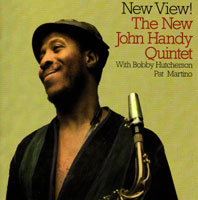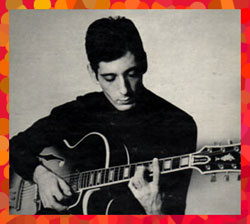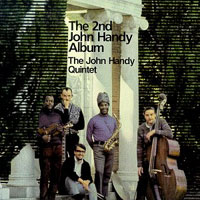

|
Soundclip:
|
| See Steve's Hand-Written Solo
Transcription |
|
Pat Martino's solo on: "A Little Quiet"(John Handy) There are so many details about my experiences in during the '60s which are now all too foggy in my memory. So, forgive me if there are some inaccuracies here. But, just for fun, let us deal with the topic at hand, and then work backwards, chronologically speaking. I do recall being most interested when I read that alto saxophonist, John Handy had put together a new group and that they had recorded live at one of New York's greatest Jazz clubs, the Village Gate. The group was to include: Bobby Hutcherson: Vibes; Albert Stinson: Ac. Bass; and Doug Sides: Drums. But, for me, then a mere student of the guitar, the young Pat Martino was going to be playing guitar. Having already heard some of his work as a sideman in various organ groups, I was really excited to hear him in another context. So when the fruits of these collaborations were reached, I was able to hear the recording "NEW VIEW!"(Columbia) in 1967. I remember being very struck by their interpretation of John Coltrane's "Naima" which they played totally rubato, out of time, and even used a very different chordal approach to the cadences. It was really beautiful and it has always stayed with me.  As I have often stated throughout these web pages, during my college years, I discovered Pat Martino's playing and actively sought to find his recorded performances on record whenever possible. So, on this particular John Handy LP, I gravitated towards his original tune, "A Little Quiet." It is a rather simple bossa nova played over a repeated 16-bar chord progression in G major. Upon hearing it for the first time, I was immediately struck by how similar it was, harmonically speaking, to one of Handy's most memorable and popular tunes titled, "Dancy Dancy" which appear on the prior LP: "THE 2nd JOHN HANDY ALBUM." Though played as fast double-time samba, it is essentially the same chord progression with one significant difference. In bar 10, "A Little Quiet" goes from Cmaj7[in bar 9] to Am7; but, on "Dancy Dancy" bar 10 is the more familiar Cm7-F7(9). Other than that one bar, and the tempos, the chord progressions for soloing are virtually identical. Those of you who are now very familiar with Pat Martino's sound and style will probably find this particular performance to be in keeping with his work from this period in his development. In my opinion, it sounds as though he was considerably easier to record during these years because there is a nice brightness and crisp quality to his tone. At the same time, it is still round and warm. His solo spans six choruses over the 16-bar form, and graduates from calmly stated single-note lines to octaves, and finally to chords. This kind of development is very much under the obvious influence of everyone's hero, Wes Montgomery. As Chorus [1] begins, Pat is following Bobby Hutcherson's vibes solo, and as this was a 'live' recording, it seems apparent that the 'cue' out of Bobby's solo was not communicated in the best fashion, because, as you will hear and see, Pat doesn't begin to solo until bar 5. Pat speaks the 'language' of Jazz with great ease. Over the m7 chords[Am7 or Dm7], you see Pat strictly adhere to the Dorian mode. Employing either A Dorian[A, B, C, D, E, F#, G] or D Dorian(D, E, F, G, A, B, C]. Over the Bm7 chord which appears each time in bar 11, in general, you would not expect to see B Dorian. This is because, the chord here is really part of a ii-V to Am7. So even though the chord itself can have an F# within it, one often sees the usage of B Locrian[B, C, D, E, F, G, A]. However, it is interesting to note that Pat does use a big F# on beat 4 of that bar as it moves to the E7(alt.) chord. This does not happen again during any of the single-note or octave choruses. On most of the V7 chords that appear within this progression, Pat places emphasis on the #9 and b9. In bar 6 of this chorus, over the D7 you see F-natural and Eb. When the D7 appears again, 4 bars later, those same notes, an octave above, reappear. On the resolution to Gmaj7 in bar 11, Pat plays a particular configuration of notes which is very common to lines over major 7th chords, and they all seem to want to end by touching upon the major 7th(F#), and then going down to the 5th(D) and up to the 6th(E). I will be pointing this out again. In Chorus [2], Pat plays the first of only two double-time 16th-note phrases during the entire solo. Normally, Pat's playing is so precise that anything he might plays appears to be so effortless, however, for some reason, his double-time phrase on this tune sound as though he was having trouble that evening.  My suspicion would be one of a couple of issues. [1] Perhaps this is just one of those rare tempos where the double-time just sits in an uncomfortable place for him. That's a bit hard to believe, but it's possible. [2] That, for some reason, he just felt uncomfortable playing with the rhythm section tandem of Albert Stinson and Doug Sides? Whatever the truth might be, the phrase in this chorus and Chorus [4] were unusually difficult to notate properly. So, as I often do, I chose to notate them based upon what I thought that Pat was attempting to play. So, if what you 'see' does not completely agree with what you 'hear' then this would be the reason. Once again, if you are new to this language, pay attention to the usage of the #9-b9 tones which appear over virtually all the D7(alt.)[F-Eb]; E7(alt.)[G-F]; and G7(alt.)[Bb-Ab] chords. Also make note of the little triplet arpeggio which appears in bars 10 & 14 over the Am7 chord, for it appears a couple more times during the solo. My suspicion would be one of a couple of issues. [1] Perhaps this is just one of those rare tempos where the double-time just sits in an uncomfortable place for him. That's a bit hard to believe, but it's possible. [2] That, for some reason, he just felt uncomfortable playing with the rhythm section tandem of Albert Stinson and Doug Sides? Whatever the truth might be, the phrase in this chorus and Chorus [4] were unusually difficult to notate properly. So, as I often do, I chose to notate them based upon what I thought that Pat was attempting to play. So, if what you 'see' does not completely agree with what you 'hear' then this would be the reason. Once again, if you are new to this language, pay attention to the usage of the #9-b9 tones which appear over virtually all the D7(alt.)[F-Eb]; E7(alt.)[G-F]; and G7(alt.)[Bb-Ab] chords. Also make note of the little triplet arpeggio which appears in bars 10 & 14 over the Am7 chord, for it appears a couple more times during the solo.As Chorus [3] begins, in bars 2-3, you see Martino using 8th-note off-beat syncopations. these always sound and feel great whether tune is played with even 8th-notes or 'swing' 8th-notes. He also does some interesting linear and modal approaches to a couple of the chords. For example, in bar 8, over the E7(alt.) chord, you see the usage of the G minor pentatonic[G, Bb, C, D, F], which is the pentatonic built upon the #9 degree, and gives you ALL the altered tones(b9, #9, b5, #5). You see a piece of this device again in bar 12. Also, over the Bm7 chord, in bar 11, you see him outline a D minor triad, this implies that he is thinking of this chord, and properly so, as a Bm7b5 sound, where I would think of applying D Dorian[D, E, F, G, A, B, C] over it. You can also take a look at the line in this same bar during Chorus [2] and Chorus [4]. I would also like to point out the line configuration in bar 4 over the Am7 chord, where you see a G# used as a lower neighbor to the root. Sometimes people like to see this as if the melodic minor is being employed, but I don't see it that way. I like to view this device as using a chromatic lower neighbor. But, what it does is that it implies a V7-im7 sense, because G# and B-natural make-up the guts of an E7 chord. Also, to pick-up on a theme we addressed previously, take a look at the line configuration of bar 9, over the Cmaj7 chord, it is the same as you saw in bar 11 of Chorus [1] over Gmaj7. Chorus [4] begins with a very nice melodic line. Then, in bars 4-7, Pat begins his only other double-time passage of this solo. Again, it simply further demonstrates that even Pat Martino is human, because this stretch of notes was most difficult to notate. I know, I'm repeating myself, but, in the end, as I always do, I simply tried to notate what I felt he was trying to execute. It is not worth it to belabor the small details of the precise phrasing because it's not really perfectly in time with the rest of the band, the pulse, the groove. The pulse is pretty clearly indicated by John Handy's maracas, which are, for better or worse, practically the loudest thing in the mix. But this is typical of small percussion instruments. When you're mixing your own recordings, be careful, especially with shakers!!! To continue, the 8th-note syncopations continue in bars 10-11. And again, in bar 15 over the Gmaj7, you see the classic major 7th Jazz line configuration. At the beginning of Chorus [5], with a sharp chordal punctuation on beat 1 of the first bar, we then see the last of Martino's single-note lines. This particular chorus is very much influenced by the great Wes Montgomery, as we mentioned earlier. All the chord voicings put to usage here, are staples from Wes' vocabulary. They are the basic inversions you might expect with those particular scale degrees in the top voice. This is the way to best remember them. These voicings usually appear as they outline chord tones ascending or descending. Rhythmically speaking, throughout this chorus, you see constant 8th-note syncopations. Just take a look at the last two bars, bars 15-16. In addition to appearances of #9-b9 over the dominant 7th chords, you also see another of Pat's favorite altered note devices for dominant 7th chords, the usage of the #5. You see it over the G7 chord in bar 8. Previously, this occurred in bar 8 of Chorus [1] and in bar 6 of Chorus [3]. Again, you have to look no further than Charlie Parker to find this type of line! As Chorus [6] finally arrives, Pat Martino goes into a full-fledged chordal solo, but unlike Wes, in bar 2, over the D7(alt.) chord, he uses parallel 13b9 voicings which descend in minor 3rds. Usually, when Wes did such things, he almost always used the very simple diminished 7th voicing. For example, spelling up from your D-string, the first chord would be: C-F#-A-Eb. In short, they all become variations of D7(b9). Once again, look at all the 8th-note syncopated rhythms, accentuating the off-beats. in bar 8, Pat uses a nice 'b5 sub' chordal device, after some very traditional Dm7 voicings, he plays an Abm7 chord on the 'and' of beat 2, and then a Db7(9) voicing[F-Cb-Eb-Ab]. However, I chose to spell that voicing as a G7(b9#5)[F-B-D#-Ab] which you can compare. I did this because, in truth, this is how the voicing is really functioning and I thought that it was important to point that out. One of the nicest chordal touches is actually the very last chord. It's a little hard to hear clearly, but I suspect that Pat only played a Bb triad there. However, in case that I am wrong, I inserted the G# on your A-string, which could easily be added in to give the full sound. Over an E7(alt.) chord, you can always play a C triad[G(#9) on top] to a Bb triad[F(b9) on top]. You often hear piano players doing this except they add the full compliment with their left-hand. It always sound lush and great as you pull down to resolution on the Am7 chord with an 'E' on top. I often refer to "speaking the language" of Jazz, and in part, this does relate to the usage of the proper modes and scales, and the insertion of a particular and specific approach to chromaticism, what I like to refer to as 'modal chromaticisim.' However, there is another crucial element which often does not get addressed. And so, I would want to point out Pat Martino's usage of various 'ornaments' which surround particular pitches, and serve to give his lines their "Jazz" flavor. In truth, if one just explores any book of Charlie Parker melodies, you would find ALL of these ornaments!  So here are the examples, in this solo, which you should look at, and listen for: Chorus [2]: bars 6 & 8; Chorus [3]: bars 10 & 14; and, in Chorus [4]: bars 7 & 12. It is my hope that the younger students of this great music will find this small detail truly helpful to their phrasing. So here are the examples, in this solo, which you should look at, and listen for: Chorus [2]: bars 6 & 8; Chorus [3]: bars 10 & 14; and, in Chorus [4]: bars 7 & 12. It is my hope that the younger students of this great music will find this small detail truly helpful to their phrasing.For those of you who never heard the earlier John Handy Quintet, of the "Dancy Dancy" years. It featured: Michael White: Violin; Don Thompson: Ac. Bass; Terry Clarke: Drums; and the wonderful, Jerry Hahn: Guitar. Some of you will probably remember Jerry's tremendous contributions to the Gary Burton Quartet, as he had the unenviable task of following the very popular and adventurously futuristic, Larry Coryell into that chair. Jerry Hahn went on to record both "COUNTRY ROADS" and "THROB" with Gary Burton before leaving the group. He has always been a very special player and comes from the great tradition of guitarists from our Midwest who have excelled. I hope that some of you will be inspired to investigate his work, past and present. On much more somber note, I have to acknowledge that the virtuoso bassist, Albert Stinson died on June 2nd, 1969 of a drug overdose. I don't believe that he had reached his 25th birthday by that time. "NEW VIEW!" would be one of his last recordings. His loss was felt by many because of the tremendous unfulfilled potential. If you are interested in hearing another one of Stinson's last recordings, you might want to investigate Bobby Hutcherson's CD, "OBLIQUE"(Blue Note) which also features the great Herbie Hancock. As always, we hope that you'll enjoy this great, though rather obscure Pat Martino solo, and will be inspired to return and explore what is offered here, or at Korner 2. It all comes to you with our best wishes.
[Photo of Pat Martino by: Don Schlitten]
|